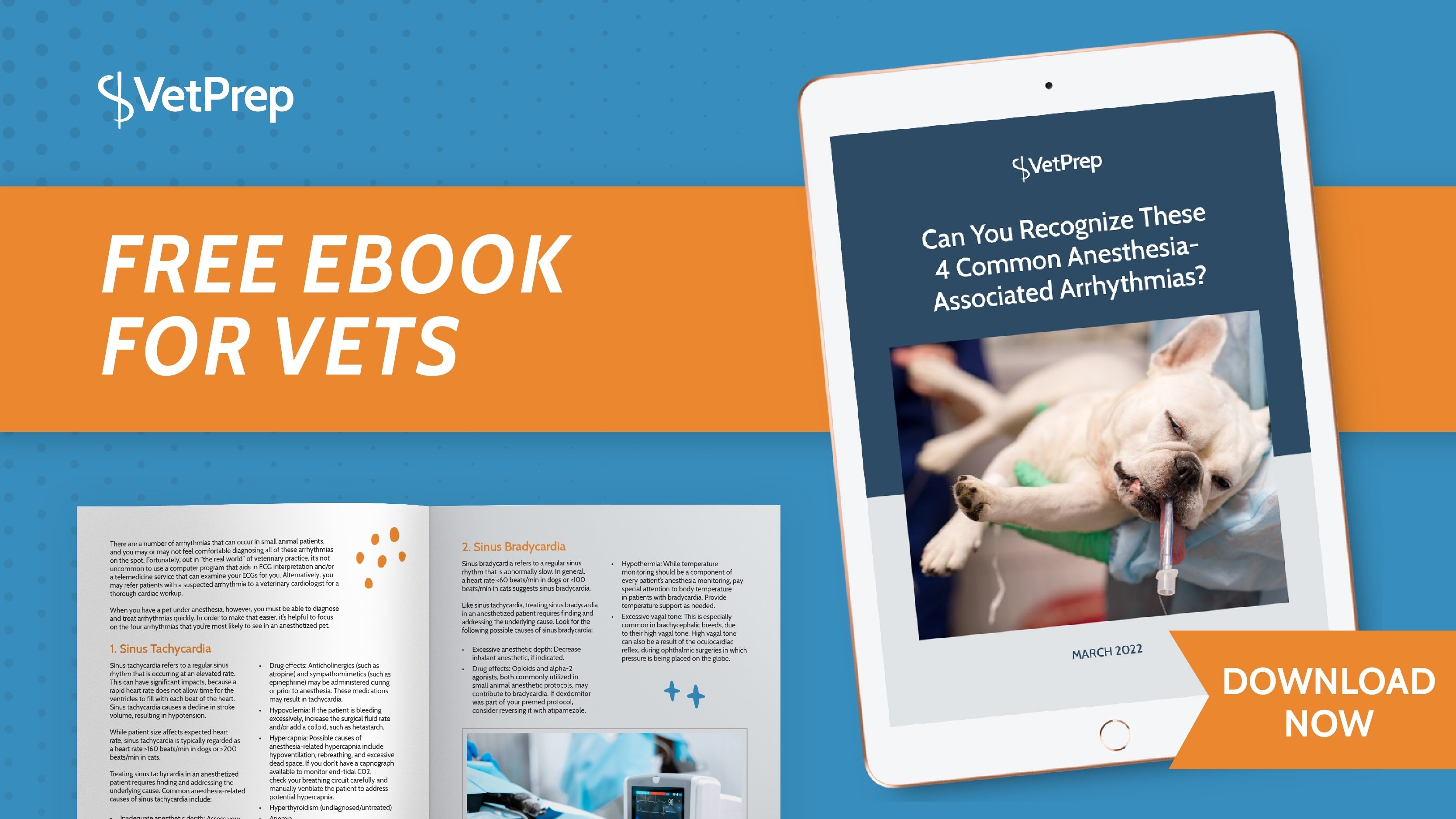
 A 9 yo MN mixed breed dog, weighing 72 pounds (32.7 kg), presented for a recent onset of panting, shortness of breath, weakness, and syncopal episodes. On physical examination, the dog’s heart rate was 160 bpm, his mucous membranes were pale, and his pulses were weak and thready.
A 9 yo MN mixed breed dog, weighing 72 pounds (32.7 kg), presented for a recent onset of panting, shortness of breath, weakness, and syncopal episodes. On physical examination, the dog’s heart rate was 160 bpm, his mucous membranes were pale, and his pulses were weak and thready.
An ECG confirmed the tachycardia, along with some additional findings. Instead of normal P waves followed by QRS complexes, the veterinarian observed an absence of P waves and complexes that were wide and bizarre.
Based on the wide, bizarre complexes occurring at a rate exceeding 100 bpm, the patient was diagnosed with ventricular tachycardia.
Treatment of Ventricular Tachycardia
An initial bolus of 65 mg lidocaine (2 mg/kg) was given IV, and the dog was closely monitored. The ventricular tachycardia resolved. Unfortunately, this resolution was short-lived, and the dog was back in ventricular tachycardia just ten minutes later. Another lidocaine bolus was given, again with a short-lived response. After four doses of lidocaine (total dose of 8 mg/kg), none with a response lasting longer than twenty minutes, the veterinarian determined that the dog needed a lidocaine constant rate infusion (CRI).
The veterinarian consulted a reference and determined that a lidocaine CRI should be delivered at a dose of 40-80 ug/kg/minute. He decided to begin with a midrange dose of 60 ug/kg/min, administered in LRS at a maintenance fluid rate of 60 ml/kg/day. The hospital stocked 1 L bags of LRS and 20 mg/ml lidocaine.
How much lidocaine should the vet add to each bag of fluids?
Stepwise Approach to Constant Rate Infusion
Although CRI calculations can be confusing, it can help to think through them in a stepwise manner. First, you’ll need to figure out the dog’s lidocaine dose, in ml/hr. Then, you can use this information to determine how much lidocaine to add to each bag of fluids.
Step 1: Figure out the dog’s lidocaine dose, in ml/hr.
Begin by multiplying your desired dose (60 ug/kg/min) by the dog’s weight:
(60 ug/kg/min) x (32.7 kg) = 1,962 ug/min
Next, convert the dose in ug/min to mg/min, because this will make your calculations easier:
(1,962 ug/min) x (0.001 mg/ug) = 1.92 mg/min
Once you have a dose in mg/min, divide by the drug’s concentration for a dose in ml/min:
(1.92 mg/min) / (20 mg/ml) = 0.096 ml/min
Finally, convert that ml/min dose into a ml/hr dose:
(0.096 ml/min) x (60 min/hr) = 5.76 ml/hr
Okay, so the dog needs 5.76 ml of lidocaine (20 mg/ml) per hour. This is the first key piece of information you need, and getting to this point is usually the hardest part. From here, the math becomes easier.
Also, if your practice has a syringe pump, you could stop at this point and administer the lidocaine via a syringe pump. If you want to administer the lidocaine in fluids, though, you will need to keep going with your calculations.
Step 2: Determine how much lidocaine to add to a 1 L bag of LRS to provide lidocaine at a rate of 5.76 ml/hr in fluids running at a rate of 60 ml/kg/day.
Your first goal here is to figure out how long a bag of fluids is going to last the patient.
First, convert the dog’s maintenance rate from mg/kg/day to ml/hr:
(60 ml/kg/day) x (32.7 kg) = 1,962 ml/day
(1,962 ml/day) / (24 hr/day) = 81.75 ml/hr
Now that you know the fluid rate of 81.75 ml/hr, you can determine how long a single bag of fluids will last the dog:
(1000 ml) / (81.75 ml/hr) = 12.2 hr
If a 1 L bag of fluids will last the dog 12.2 hours, and you want the dog to receive 5.76 mls of lidocaine per hour, how many mls of lidocaine must you add to each bag of fluids?
(12.2 hr) x (5.76 ml/hr) = 70.3 ml
Therefore, you will want to add 70.3 ml of lidocaine (20 mg/ml) to the dog’s bag of LRS. This will ensure that the dog receives 60 ug/kg/hr of lidocaine when the fluids are delivered at 81.75 ml/hr. (Don’t forget to remove 70.3 ml of LRS before adding the 70.3 ml of lidocaine!)
Summary
When performing CRI calculations, divide the math into steps. First, convert the patient’s dose from ug/kg/min to ml/hr. Once you have done that, you can either administer the CRI using a syringe pump or go on to determine how much drug must be added to a bag of fluids. If the drug will be added to fluids, think about how long the fluid bag will last the patient, and how much drug the patient must receive over that time period.



